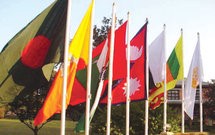 The 18th South Asian Association for Regional Cooperation (SAARC) Summit is taking place in Kathmandu at the historic moment when South Asia is going through massive transformation. India elected Narendra Modi as its prime minister with an overwhelming majority.
The 18th South Asian Association for Regional Cooperation (SAARC) Summit is taking place in Kathmandu at the historic moment when South Asia is going through massive transformation. India elected Narendra Modi as its prime minister with an overwhelming majority.
Nepal voted for the second Constituent Assembly after the first failed to deliver the constitution within the stipulated time. Afghanistan, the newly inducted member of SAARC voted for Ashraf Ghani as its president. Sheikh Hasina and Nawaz Sharif were elected to the prime minister’s positions in Bangladesh and Pakistan respectively. The King of Bhutan devolved powers to his country-people who aspired for democracy.
Media reports suggest that three agreements – SAARC Railway Agreement, SAARC Motor Vehicle Agreement and SAARC Framework Agreement on Energy Cooperation – might be signed during the 18th SAARC Summit, scheduled for 26-27 November.
Formation of the SAARC
The SAARC was formed by Bangladesh, Bhutan, India, Maldives, Nepal, Pakistan and Sri Lanka to actualise their common goals, economic cooperation being one of them. Afghanistan was introduced as the newest member, in 2007.
Regionalism began and flourished around the world after World War II with the aim of liberalising trade among the member states of respective blocs. The end of the Cold War further strengthened their commitments towards greater economic cooperation via free trade agreements, such as in the European Union, the Arab Maghreb Union, the Association of Southeast Asian Nations, the Caribbean Community, the Common Southern Market, and the Southern African Development Community. With the EU’s success story, there has been a rise in the number of such regional organisations. Founded in 1985, SAARC was a late arrival in following the growing trend of regionalism.
Opportune Moment for SAARC
South Asia can have tremendous opportunity as the economy of the region has great impact on the global economy. The epicenter of global economy is gradually shifting towards the east with the emergence of China and India as the largest economies. Economic integration within South Asia region possesses great opportunity; China’s inclusion can change the game altogether. It is possible that China applied for observer status in the SAARC due to this potential. The challenge facing the leaders of SAARC member countries is to materialise the enormous potential for the betterment of the people of the region. South Asia is the least integrated region in the world with the lowest intra-regional trade. There is a pressing need for a speedy implementation of the South Asian Free Trade Agreement.
Challenges
South Asian regionalism has been suffering due to bilateral tensions and differences between the member countries. The region has a long history of conflicts, especially between India and Pakistan – who have fought four wars since 1947. Though the India-Pakistan rivalry is often blamed for SAARC’s failure, the reasons are in fact deeper and structural in nature. The geographical, ethnic, historical and political factors have gridlocked SAARC and will persist unless India adopts proactive confidence-building measures.
One of the major reasons for the failure of SAARC is that one of its members is much larger than all of its other members put together. India accounts for over 60 per cent of SAARC’s geographcical area, population, GDP, foreign exchange, gold reserves and armed forces. The huge resource and power imbalance generates an acute sense of insecurity among the member countries. Moreover, its relationship with the second largest member, Pakistan, causes polarisation instead of regional harmony owing to their historical conflict. Similarly, India shares boundaries (land and/or maritime) with all the member countries while they, (barring Pakistan and Afghanistan) do not share boundaries with each other. The existing unsettled border disputes and increasing conventional conflicts with India has increased a sense of insecurity among its neighbours.
Another important factor that hinders regional cooperation is the variation in their political beliefs. South Asia has witnessed all types of political systems – democracy, monarchy and dictatorship. India being the matured democracy and propagator of democracy in the region created asymmetry in political dealings among the member countries. Insecurity and distrust among the member countries forced smaller member countries to bandwagon with external powers (or other member countries) to balance India – thus hampering regional cooperation.
Modi’s invitation to the heads of governments of the SAARC member-states to his swearing-in ceremony was perhaps a signal that under his tenure as the prime minister, India would prioritise its neighbourhood. He visited Bhutan and Nepal and shared India’s desire to establish a SAARC satellite. One has to wait and watch if Modi would be able to fulfill those promises.
In order to revive the SAARC, one or more member countries can take initiatives to reduce distrust and insecurities among the member countries. Similarly, like-minded SAARC countries can form a sub-regional group and enjoy the benefits of regional cooperation. But cooperation in the sub-regional group which includes India will have limited cooperation within SAARC, while a sub-regional group that does not include India will suffer from a lack of contiguity and capacity constraints. India, being the largest economy of South Asia should show its benevolence and bear the cost of rejuvenating the SAARC for promoting regional cooperation in the region. Despite of the discouraging past, there is optimism among the member countries as all the South Asian countries have adopted democracy and are realising the benefits of regionalism.
By Special Arrangement with Institute of Peace and Conflict Studies (http://www.ipcs.org)